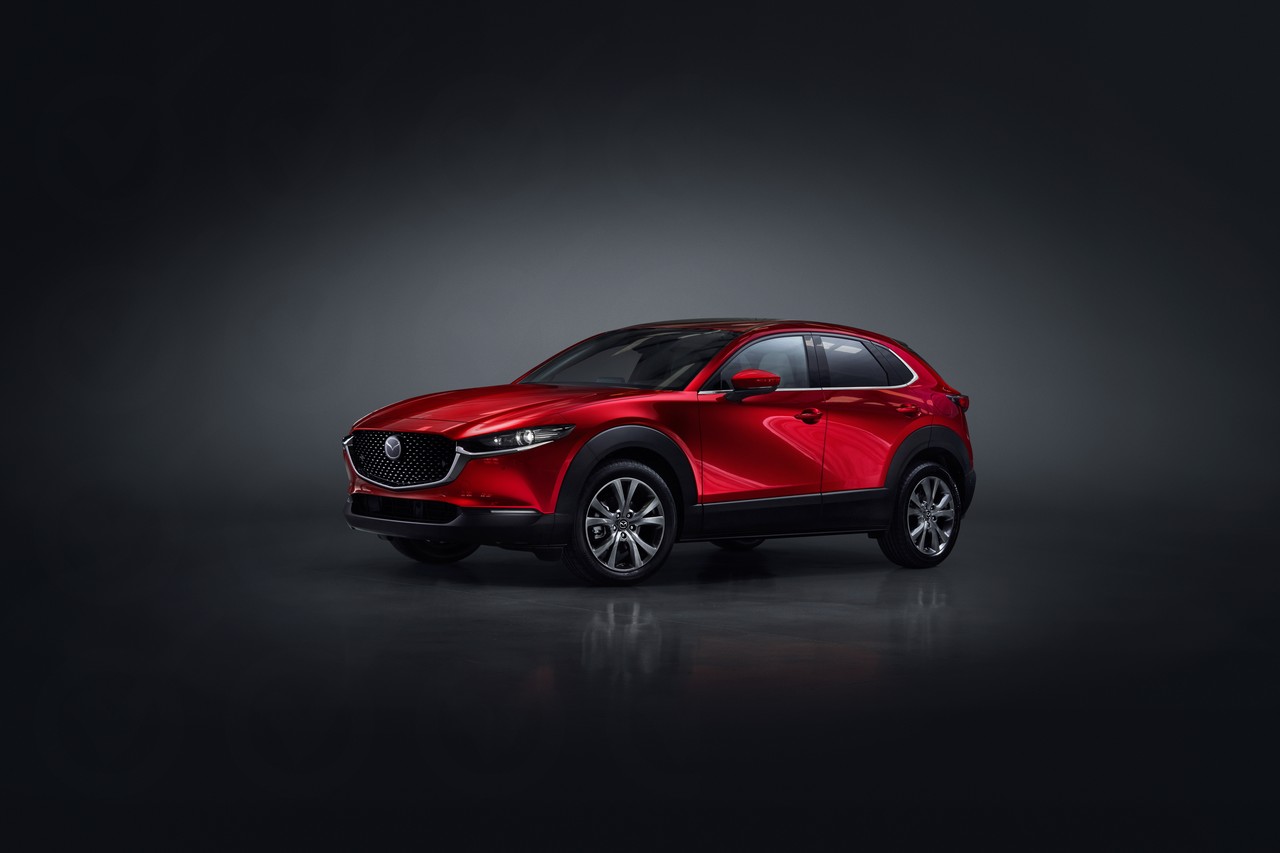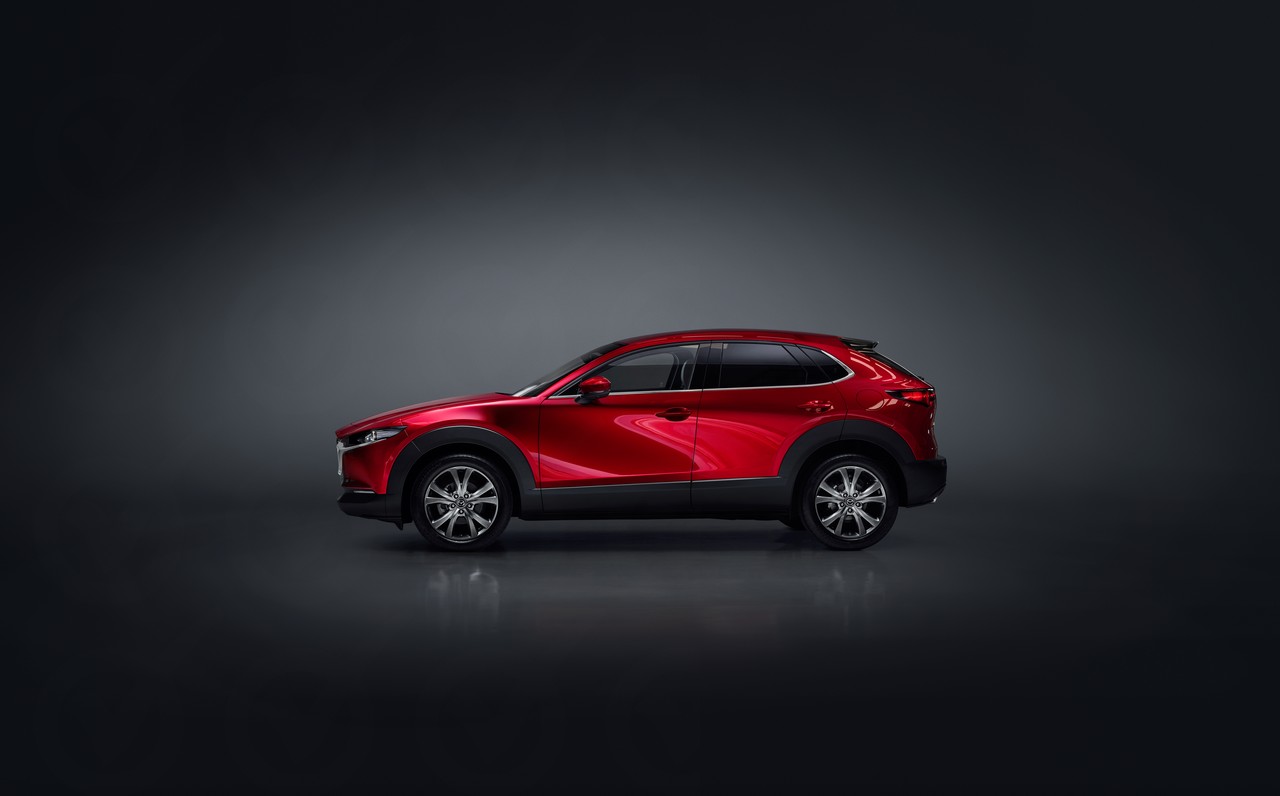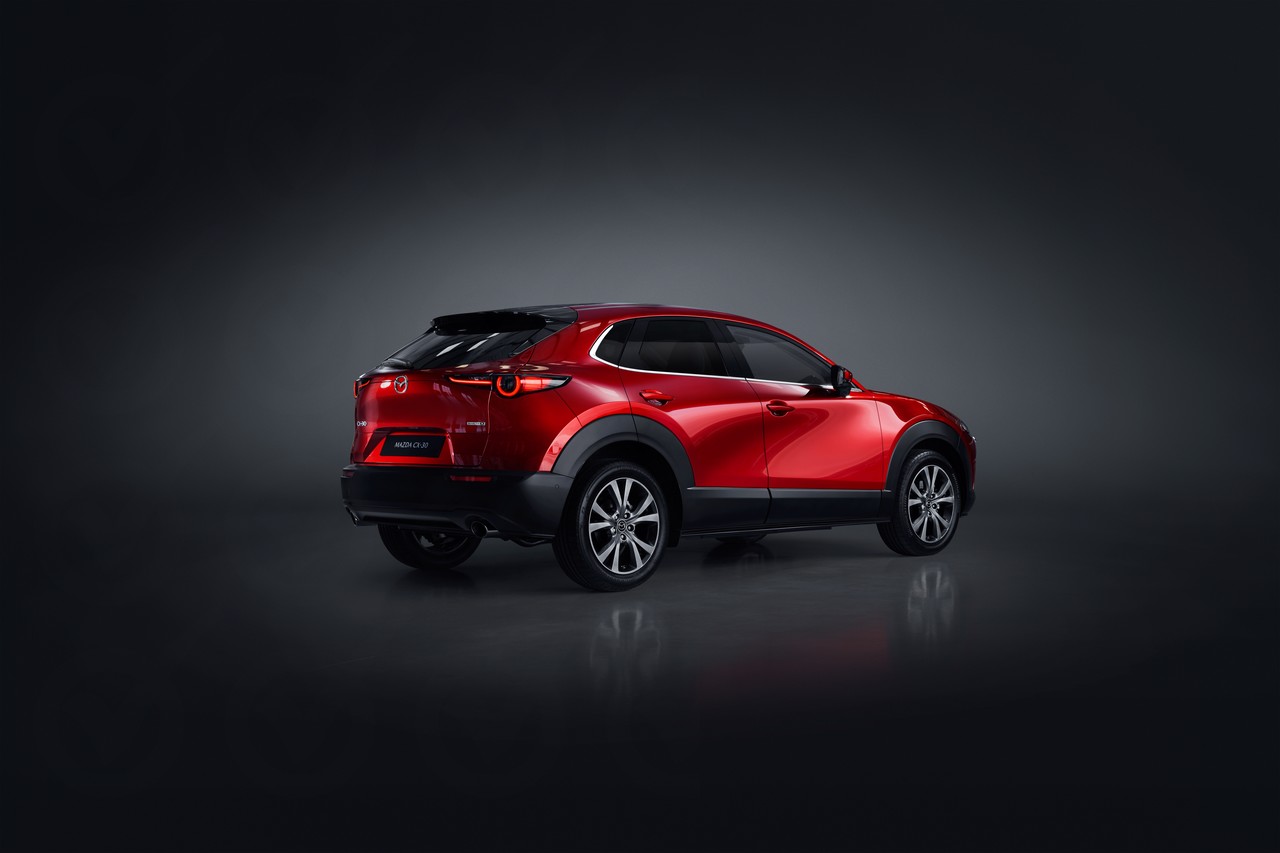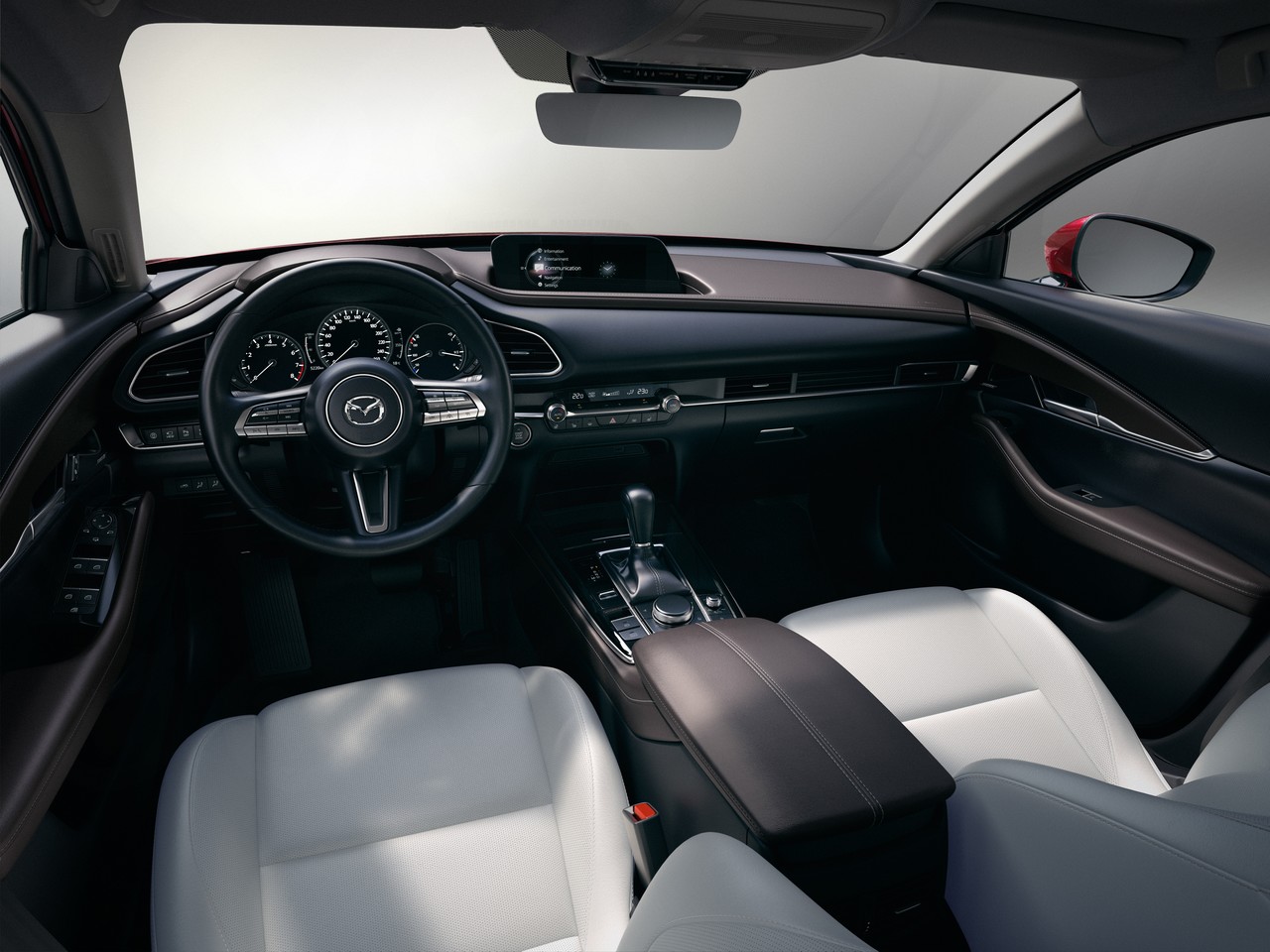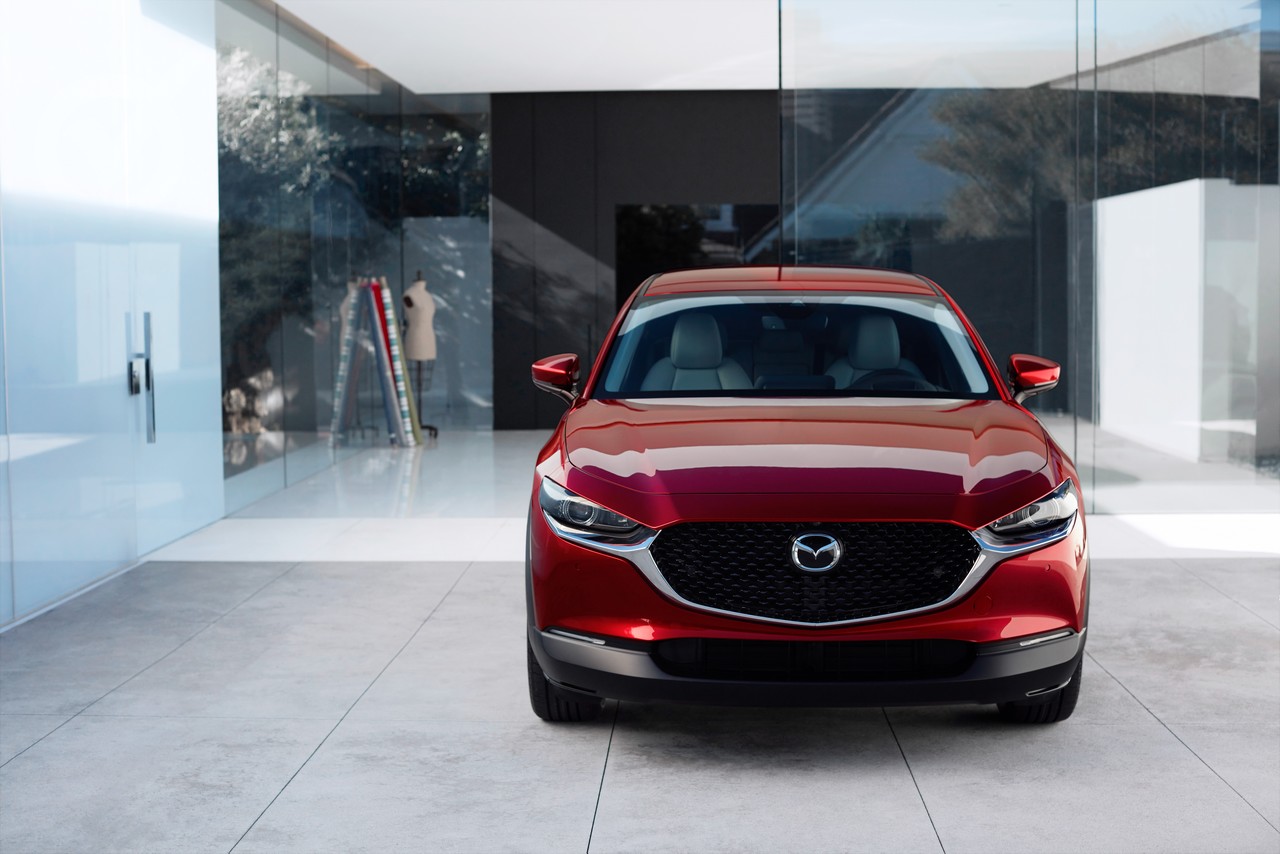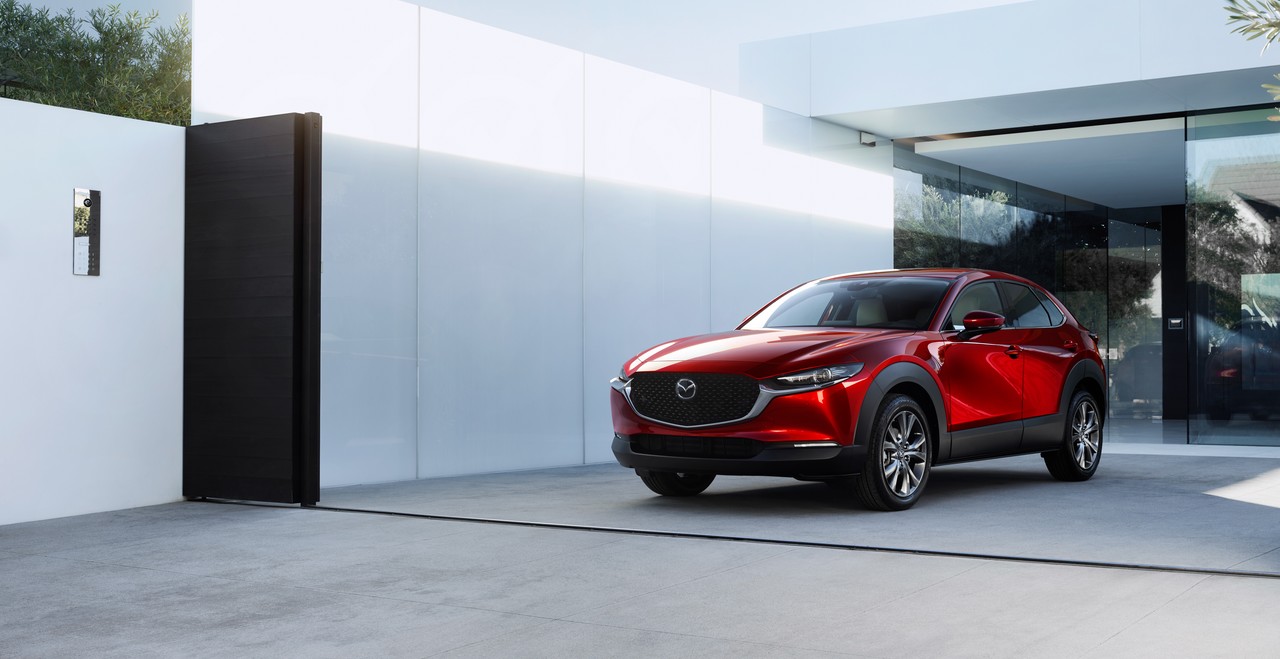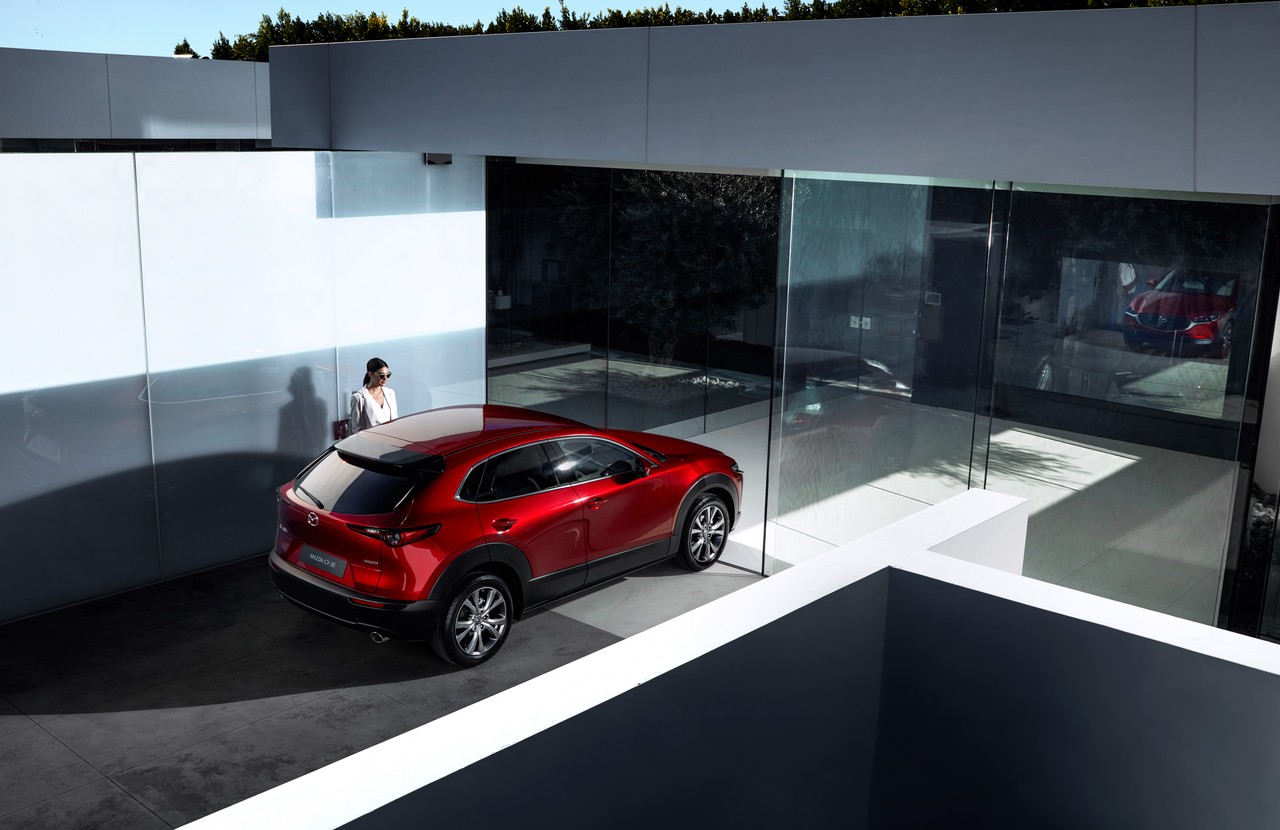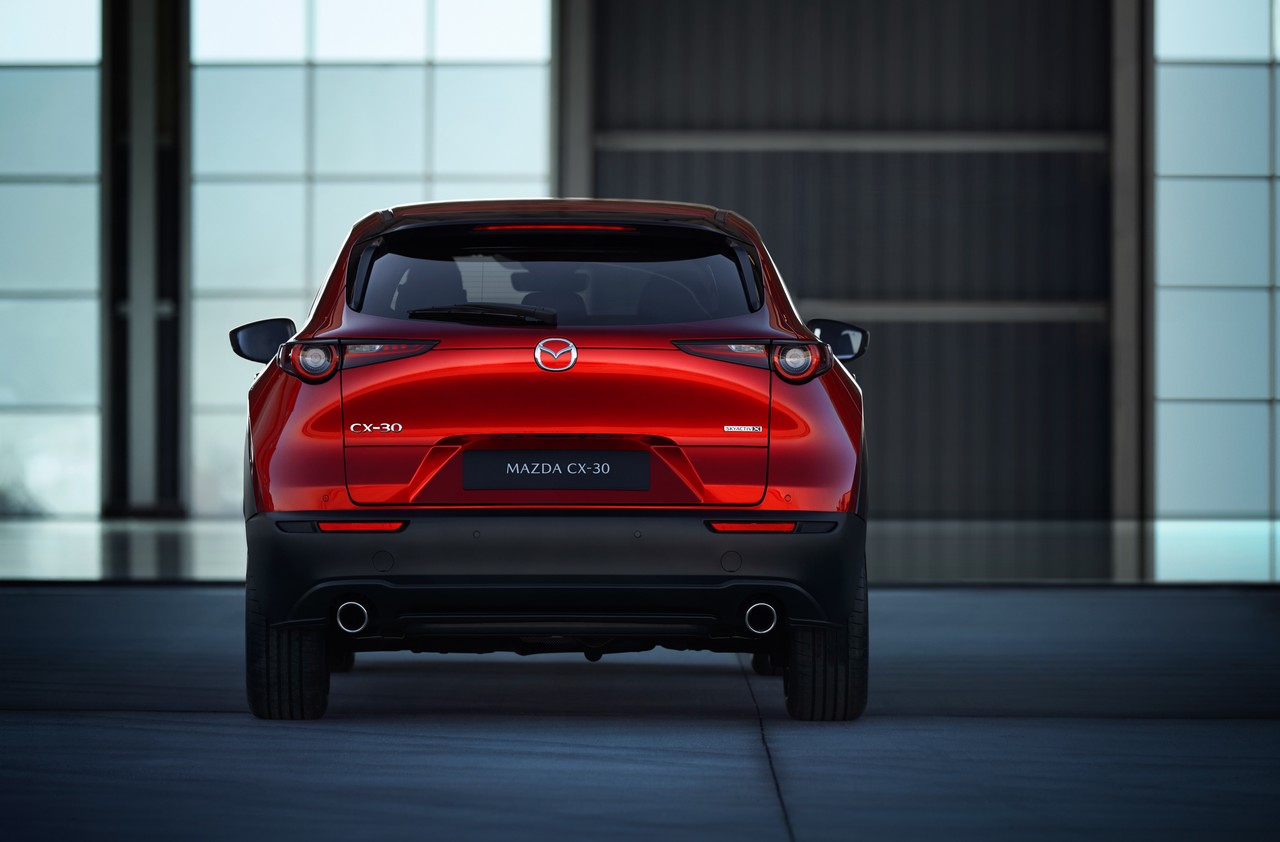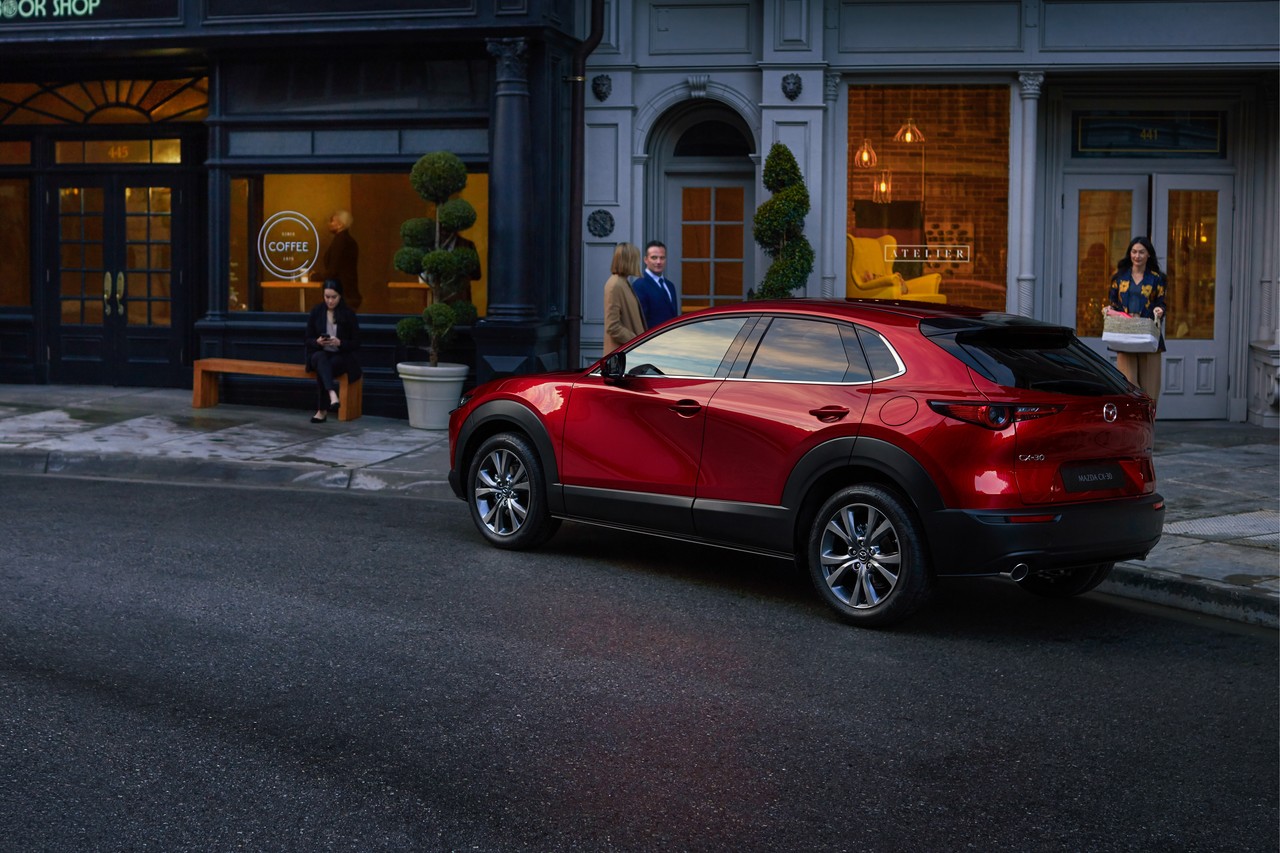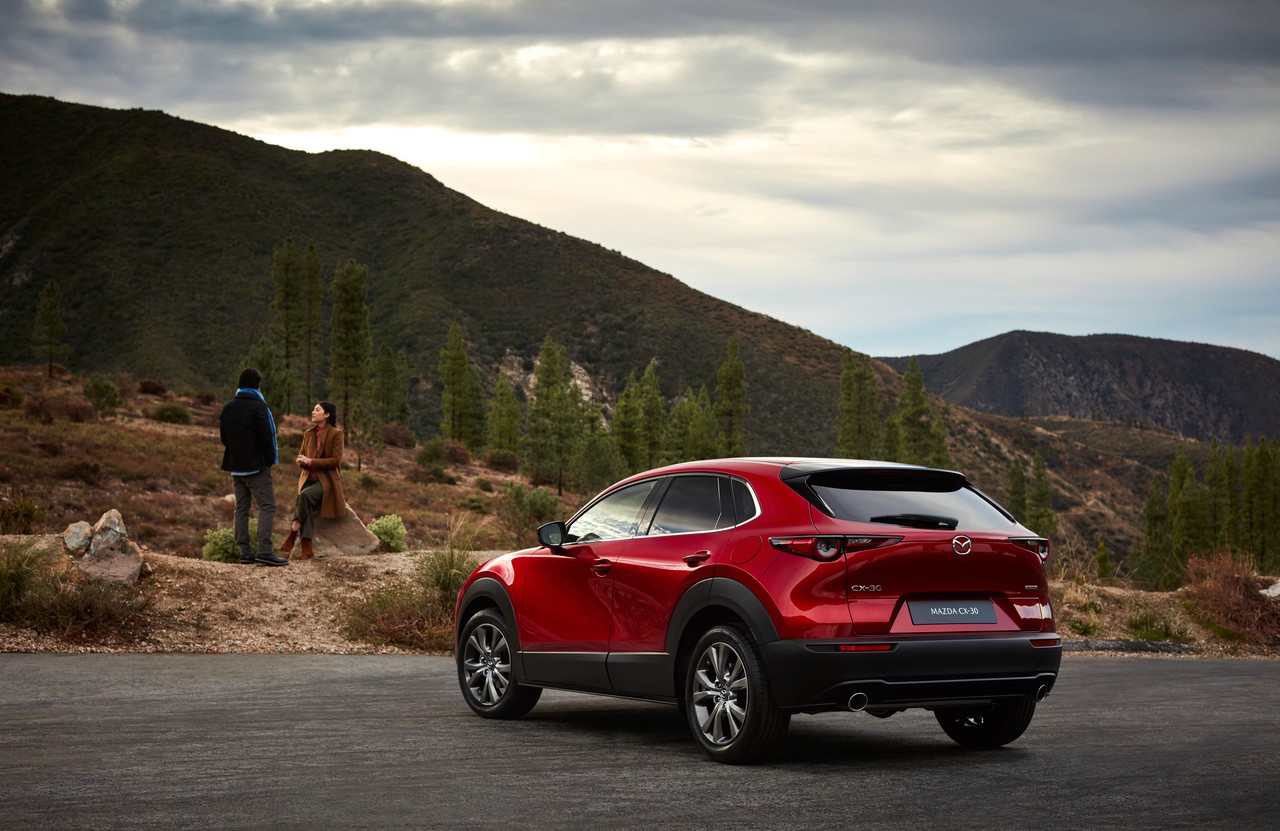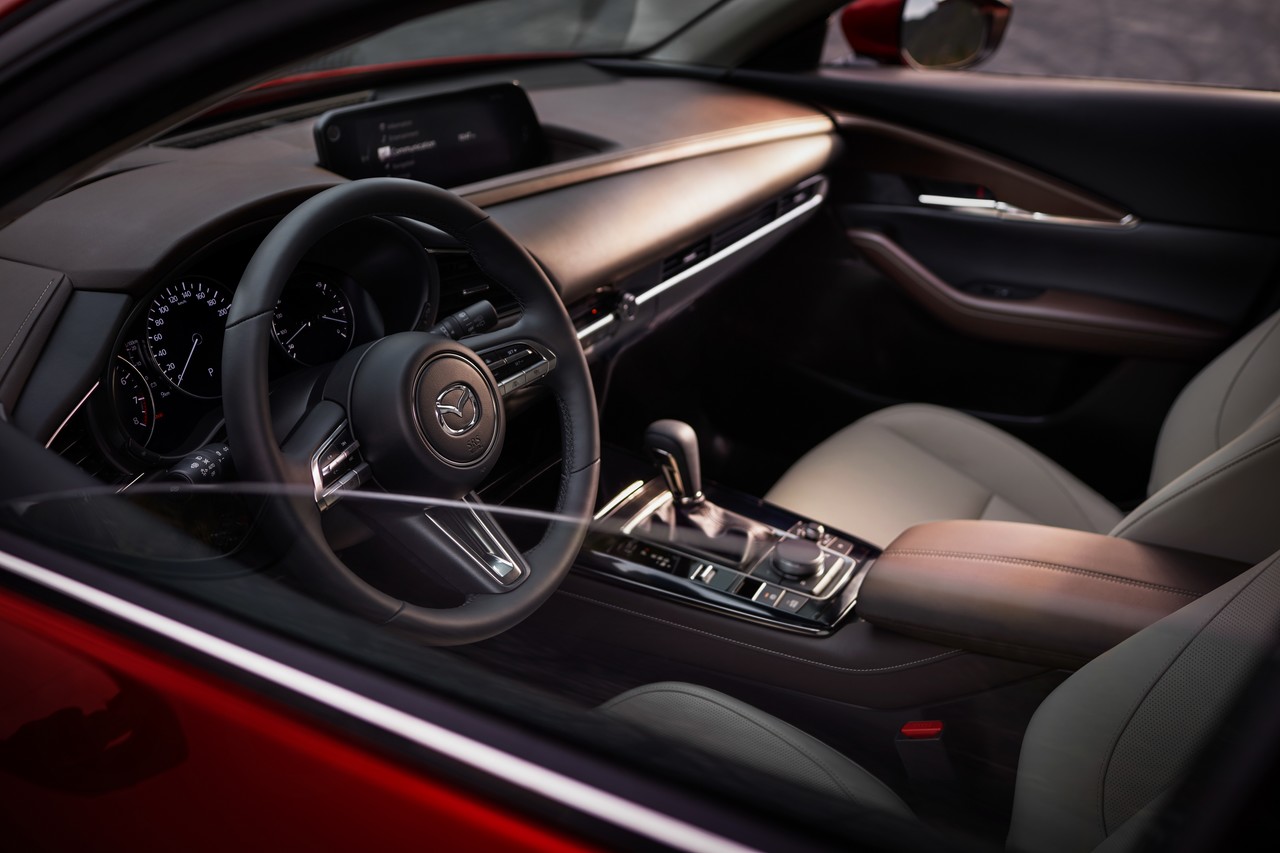
- Autonomous Emergency Braking fitted as standard
- For passive safety, ‘SkyActiv’ vehicle architecture makes extensive use of high tensile steels
- Mazda is promising improved sound insulation…
- … though we’ve heard this before
- Not all active safety technologies likely to be standard
- Torsion beam rear suspension rather than multi-link
Overview
Expected to be released in Australia in the third quarter of 2019, the Mazda CX-30 is a compact crossover. To be manufactured in Japan, the Mazda CX-30 will be powered by a 2.0-litre petrol engine that is mated to six-speed manual or automatic transmissions. Like the Mazda BP Mazda3 , AustralianCar.Reviews expects the CX-30 to be offered in Pure, Evolve, Touring and GT editions.
Within Mazda’s range, the Mazda CX-30 is positioned between the Mazda DK CX-3 and Mazda KF CX-5 .
| Variant | Engine | Trans. | Peak power | Peak torque |
|---|---|---|---|---|
| SkyActiv-G 2.0 (i-stop) | 1998 cc PE-VPS petrol I4 |
6sp man., 6sp auto |
114 kW at 6000 rpm | 200 Nm at 4000 rpm |
i-ACTIV AWD system
The Mazda CX-30 will be available with an on-demand all-wheel drive system, Mazda’s ‘i-Active AWD’. As such, the vehicle is driven by the front wheels in normal conditions, though torque can be directed to the rear wheels in the event that a loss of traction is experienced or anticipated. According to Mazda, the i-Activ AWD system:
- Has four-wheel vertical load detection; and,
- Reduces overall mechanical loss by approximately 60 per cent over the previous model.
G-Vectoring Control Plus (GVC Plus)
Previously introduced in the Mazda KF CX-5 , the Mazda CX-30 will be equipped with Mazda’s G-Vectoring Control Plus (GVC Plus). G-Vectoring Control Plus has two functions:
- As the steering wheel is turned, engine torque is slightly reduced – usually by 0.01 g or less – to generate a small shift in load to the front axle. According to Mazda, this torque reduction improved cornering response by optimising the vertical load on each wheel; and,
- Light braking force is applied to the outer wheels when cornering as the steering wheel returns to the centre position, providing a ‘recovery moment’ to restore the vehicle to straight line running. As such, the vehicle is more stable after initial emergency avoidance actions and when driving on slippery surfaces.
Body and dimensions
The Mazda CX-30 shares its ‘Skyactiv-Vehicle Architecture’ with the Mazda BP Mazda3 . As such,
- The chassis uses 1310 MPa ultra-high-tensile steel for the bumper beam and B-pillars;
- 1180 MPa steel is used for the side sills;
- The ratio of ultra-high-tensile steel rated 980 MPa or higher is 30 per cent;
- 780 MPa high-tensile steel is used for the door hinges;
- For a rigid body, front-to-back connections complement conventional vertical and lateral connections to form multi-directional ring structures; and,
- Perimeter beam and rear side frames deform in an accordion-style pattern to absorb energy in the event of a collision.
Compared to the Mazda DK CX-3 , the Mazda CX-30 is 120 mm longer (at 4395 mm), 30 mm wider (1795 mm), the same height (1540 mm) and has an 85 mm longer wheelbase (2655 mm). Including its ‘sub-trunk’ (i.e. beneath the cargo floor), the Mazda CX30 has a luggage capacity of 430 litres.
To reduce noise, vibration and harshness (NVH), the Mazda CX-30 has a ‘two-wall’ structure that leaves space between the body and carpeting on the floor. Furthermore, the number of holes in the carpeting has been reduced to improve sound insulation and sound-absorbing material is used in the headliner and floor mats to supress high-frequency noise.
Suspension and steering
The Mazda CX-30 has MacPherson strut front suspension and torsion beam rear suspension. According to Mazda, a spherical shape has been adopted for the internal structure of the bushings.
The Mazda CX-30 has rack-and-pinion steering with electric power assistance.
Safety equipment
Standard safety equipment for the Mazda CX-30 includes dual front airbags, a driver’s knee airbag, front side airbags, full-length curtain airbags, ABS, electronic brake force distribution, brake assist, electronic stability control, traction control, active front seat head restraints and front seatbelts with pre-tensioners and load limiters. For the front side airbags, each airbag is divided into a front and rear chamber. Using reduced air pressure in the forward chamber and higher pressure in the rear chamber reduces the load taken by the rib cage while holding the body in place.
The Mazda CX-30 is expected to be equipped with the following ‘i-ActiveSense’ safety technologies as standard –
- Smart Brake Support (SBS) with Forward Obstruction Warning (FOW): operating at speeds between 15 km/h and 160 km/h, SBS uses a milliwave radar sensor and a forward sensing camera to detect vehicles or obstacles on the road ahead. If a potential collision is assessed, an initial alert sounds (Mazda’s ‘Forward Obstruction Warning’) and the brakes are pressurised. In its secondary phase, SBS applies the brakes lightly to alert the driver and reduce vehicle speed. If a collision is inevitable, SBS applies maximum braking force. In the event that the driver applies the brakes, maximum braking force would be applied;
- Smart Brake Support – Rear (SBS R): operating at speeds between 2 km/h and 8 km/h, SBS R uses ultrasound sensors in the rear bumper to detect obstacles up to two metres behind the vehicle. When an obstacle is detected and a high risk of collision is assessed, the brakes are applied automatically to avoid or reduce the severity of the collision;
- Mazda Radar Cruise Control (MRCC) with stop & go: operating at speeds from stationary to 145 km/h, MRCC uses a milliwave radar to judge the relative speed of and distance to the vehicle ahead. In accordance with the target speed set by the driver, MRCC adjusts vehicle speed to maintain a safe distance to the vehicle ahead. Furthermore, the ‘Stop & Go’ function enables the vehicle to brake until stationary and, when the traffic ahead started to move, automatically accelerate;
- Lane-keep Assist System (LAS) and Lane Departure Warning (LDW): uses a forward-sensing camera to monitor lane markings on the road surface and assists the driver to stay in their lane by providing steering torque assistance and steering wheel vibration alerts. The driver can choose from ‘Early’ or ‘Late’ settings to adjust the level of assistance and the timing of its operation. In the ‘Early’ setting, for example, the system provides continuous steering assistance to keep the vehicle in the centre of its lane;
- Rear Cross Traffic Alert (RCTA): could warn the driver of approaching traffic when reversing from a parking space by sounding an audible alert and illuminating LED icons in the door mirrors; and,
- Traffic Sign Recognition (TSR): uses the forward-facing camera to detect speed limit, ‘No Entry’ and ‘Stop’ signs while driving and displays them on the Active Driving Display;
- Intelligent Speed Assist (ISA): if the vehicle exceeds the speed limit, the driver is alerted by blinking graphics on the display and an audible alert; and,
- Driver Attention Alert (DAA): operating at speeds above 65 km/h, DAA initially observes driver behaviour – such as steering wheel operation, vehicle speed and lane positioning – for 20 minutes to establish a benchmark. The DAA system then monitors driver behaviour for signs of fatigue and recommends rest breaks if detected. Alerts would also be issued if the driver had been driving continuously for more than two hours.
Beyond this, AustralianCar.Reviews expects the following safety technologies to be available as part of an extra-cost ‘Vision Technology’ package, but standard for the CX-30 GT –
- Smart Brake Support – Rear Crossing (SBS-RC): working in conjunction with the Rear Cross Traffic Alert system, SBS RC would apply the brakes if the driver attempted to reverse when there was crossing traffic approaching from the rear;
- Front Cross Traffic Alert (FCTA): operates at speeds up to 10 km/h and uses front side radars to detect other vehicles approaching from blind spots at the front right or left of the vehicle. If detected, a warning tone sounds to alert the driver to their presence;
- Cruising & Traffic Support (CTS): reduces driver fatigue by assisting with accelerator, brake pedal and steering operations when stuck in traffic jams; and,
- A Driver Monitoring system: uses an infra-red camera and infra-red LED to observe the driver behaviour while driving. The system monitors the driver’s line of sight and eye movement, how open the driver’s eyelids are, blinking frequency and the angle of the mouth and face to measure drowsiness or fatigue. If the system determines that the situation has become dangerous, it sounds an alert to make the driver aware and works in conjunction with the Smart Brake Support (SBS) system to shorten the time required for the brake warning to sound.
Features: Mazda CX-30
The standard ‘Mazda Connect’ infotainment system for the Mazda CX-30 consists of an eight speaker audio system (including 3 litre woofers at the sides of the cowl, 2.5 cm tweeters on the left and right sail garnishes and 8 cm squawkers on the upper section of the front and rear door trim), digital radio tuner (DAB+), an 8.8-inch touchscreen, satellite navigation, Bluetooth mobile phone connectivity and audio streaming, Apple CarPlay and Android Auto smartphone integration, and a USB input.
Beyond this, standard features for the Mazda CX-30 are expected to include 16-inch alloy wheels, LED headlamps with High Beam Control, LED daytime running lamps, a reverse camera, rear parking sensors, a head-up display (Mazda’s ‘Active Driving Display’), 60/40 split-fold rear seats, remote central locking, power adjustable mirrors with auto-folding function, power windows, tilt and telescopic steering wheel adjustment, push-button start, a seven-inch TFT LCD multi-information display, vanity mirrors, tyre pressure monitoring, an electric parking brake, a trip computer and an immobiliser.
As an option, the Mazda CX-30 will be available with a 12 speaker Bose sound system which includes an 8 cm centre speaker, two rear satellite speakers and a subwoofer.
Further information regarding features will be available closer to launch.
